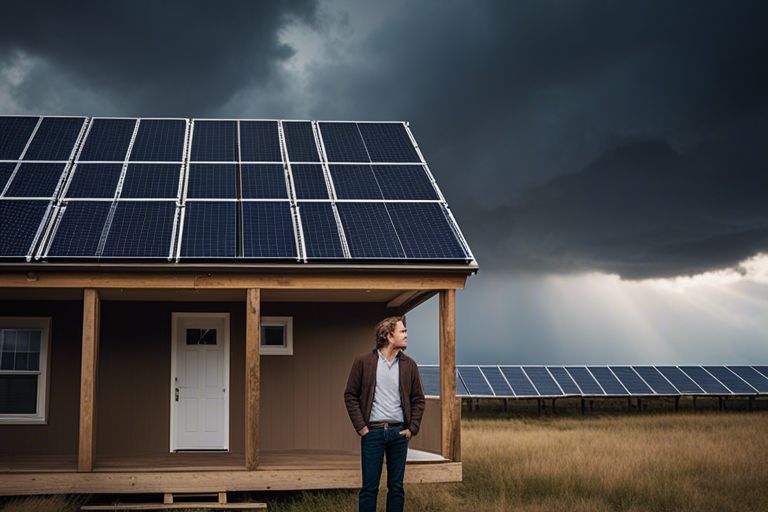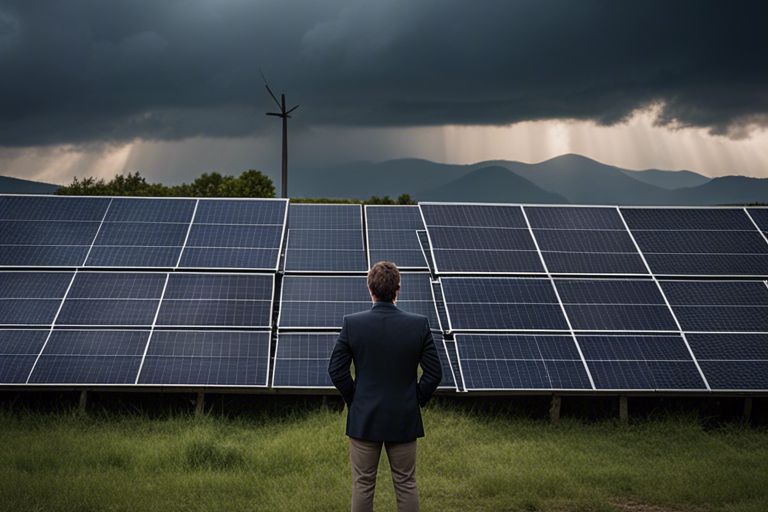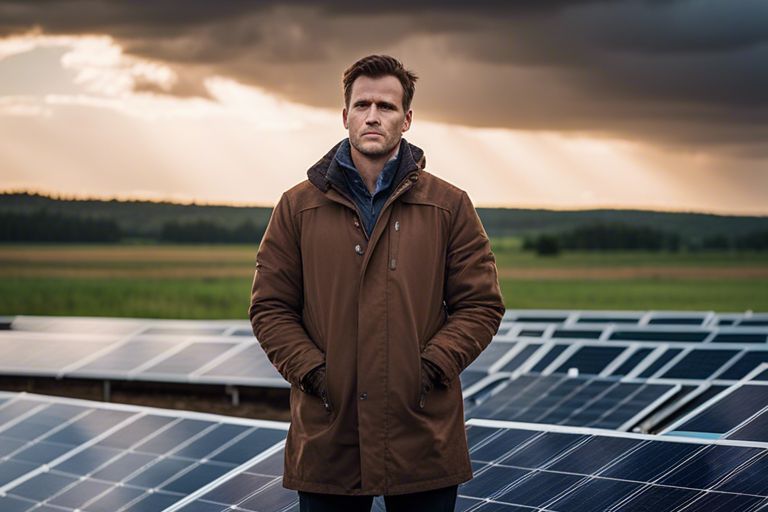Just when you thought solar panels were the ultimate solution, think again. Despite the green promises and energy savings, the reality may not live up to the hype. Before you jump on the solar bandwagon, let’s examine why investing in solar panels might not be the golden ticket you were led to believe.
Key Takeaways:
- High upfront costs: Solar panels require a significant initial investment, which may not provide a return on investment for many years.
- Unpredictable energy production: Solar panels rely on sunlight to generate electricity, leading to inconsistent production during cloudy days or at night.
- Maintenance and efficiency issues: Solar panels require regular maintenance and can lose efficiency over time, leading to additional costs and potentially lower energy output.

The High Upfront Costs
While solar panels can offer long-term financial benefits, the initial investment required can be a deterrent for many homeowners. The cost of purchasing and installing solar panels can be significant, ranging from $15,000 to $25,000 or more for the average home. This upfront cost can be a barrier for those who may not have the capital readily available or are hesitant to make such a substantial financial commitment.
Initial Investment vs. Long-term Savings
| Initial Investment | Long-term Savings |
| High upfront costs | Lower or eliminate electricity bills over time |
| Requires financial commitment | Potential for return on investment in the long run |
Comparing Costs to Traditional Energy Sources
| Longterm Costs | Comparing Costs to Traditional Energy Sources |
| Lower or eliminate monthly electricity expenses | Higher upfront costs compared to traditional energy sources |
While solar panels can lead to savings on your electricity bills in the long run, the initial costs can be a significant consideration. Additionally, when comparing the costs of solar panels to traditional energy sources such as fossil fuels, the higher upfront investment for solar may not always seem worth it for some homeowners.
Inefficiency and Intermittency
Clearly, one of the main reasons why solar panels may not be worth it is their inefficiency and intermittency. While solar panels can harness energy from the sun, they are limited in their energy generation during peak hours when the sun is shining the brightest.
Limited Energy Generation During Peak Hours
During peak hours, you would expect solar panels to generate the most energy. However, factors such as weather conditions, shading, and the angle of the sun can affect the efficiency of solar panels. This means that during the times when you need the most energy, solar panels may not be able to deliver as much as you would expect.
The Problem of Energy Storage
Peak energy generation from solar panels often doesn’t align with peak energy consumption times. This creates a problem of energy storage. While you can generate excess energy during the day, storing it for use during the night or cloudy days can be a challenge. This leads to a dependency on traditional energy sources to supplement when solar energy is not sufficient.
Plus, the cost of implementing adequate energy storage solutions such as batteries adds to the overall expense of solar panel systems, further diminishing their cost-effectiveness.
Environmental Impact
Land Use and Habitat Destruction
Many proponents of solar panels tout their environmental benefits, but you should consider the land use and habitat destruction involved in their production. Solar farms require vast amounts of land, often in pristine natural areas. This can lead to habitat destruction, disrupting local ecosystems and displacing wildlife. So, while solar energy is renewable, the process of harnessing it can have a significant impact on the environment.
Manufacturing Process Emissions
Environmental concerns also arise during the manufacturing process of solar panels. The production of solar panels involves the emission of greenhouse gases and other pollutants. While these emissions may be lower than those produced by fossil fuels over the panels’ lifetime, they still contribute to environmental degradation. It’s important to weigh the environmental costs of manufacturing solar panels against their long-term benefits.
Process: The manufacturing of solar panels involves the use of various chemicals and materials, some of which are toxic and hazardous to the environment. These substances can have long-lasting effects on ecosystems if not properly managed. So, while solar panels may be a cleaner energy source during their operation, their manufacturing process raises valid environmental concerns that should not be overlooked.

Technological Limitations
Energy Conversion Efficiency
Unlike what some may lead you to believe, the energy conversion efficiency of solar panels is not as impressive as it may seem at first glance. With current technology, most solar panels have an energy conversion efficiency of around 15-20%, meaning that only a fraction of the sunlight they receive can be converted into usable electricity. This limitation translates to the need for larger and more costly solar panel installations to generate the desired amount of electricity for your needs.
Degradation Over Time
With solar panels, another significant technological limitation to consider is degradation over time. As solar panels age, their efficiency decreases gradually. On average, solar panels degrade at a rate of about 0.5% per year. This means that after 20 years, the solar panels you initially installed may only operate at about 90% of their original efficiency. In practical terms, this degradation equates to decreased energy output and increased maintenance costs over the lifespan of the system.
Understanding the technological limitations of solar panels is crucial in making an informed decision about whether they are a worthwhile investment for your energy needs. While solar energy is a promising renewable energy source, it’s vital to weigh these factors against the potential benefits to determine if solar panels are truly worth it for you in the long run.
Government Subsidies and Incentives
Not only do solar panels come with a hefty price tag, but their value is further complicated by government subsidies and incentives that can skew the playing field.
The Role of Politics in Solar Panel Adoption
Role politics play a significant part in the adoption of solar panels. The availability and amount of government subsidies and incentives for solar panel installation vary widely depending on where you live. This means that your ability to afford and benefit from solar energy may be heavily influenced by the political landscape of your region.
The Inequity of Subsidies for Wealthy Homeowners
The inequity of subsidies for wealthy homeowners is a crucial aspect to consider. Government incentives often end up disproportionately benefiting wealthier households who can already afford the upfront cost of solar panels. This results in a situation where lower-income families, who may stand to benefit the most from reduced energy bills, are left out of the equation.
Adoption of solar panels may be hindered by these disparities, creating a system where those who need the cost savings the most have the least access to government support for renewable energy solutions.

Alternative Energy Sources
Despite the drawbacks of solar panels, there are other alternative energy sources that show promise in providing sustainable power solutions for the future. Two such sources are nuclear power and hydrokinetic energy, each offering their own benefits and challenges.
The Rise of Nuclear Power
With advancements in technology, nuclear power has emerged as a reliable source of clean energy. Unlike solar panels, nuclear power plants can produce large amounts of electricity consistently, without being dependent on weather conditions. Although there are concerns about nuclear waste disposal and potential accidents, many countries are investing in nuclear power as a way to reduce carbon emissions and meet growing energy demands.
The Promise of Hydrokinetic Energy
One of the most intriguing alternative energy sources is hydrokinetic energy, which harnesses the power of moving water such as rivers, tides, and ocean currents to generate electricity. This technology has the advantage of being predictable and reliable, making it a promising option for regions with strong water currents. By tapping into the kinetic energy of water, hydrokinetic systems can provide a constant source of power without the intermittent nature of solar panels.
The potential of hydrokinetic energy lies in its ability to generate electricity continuously, offering a stable and predictable energy source that is not subject to the variability of weather patterns. As research and development in this field progress, hydrokinetic energy could play a significant role in diversifying the energy mix and reducing reliance on fossil fuels.
Conclusion
On the whole, it seems that investing in solar panels may not be a worthwhile endeavor for you. The initial costs, maintenance fees, and the time it takes to recoup your investment might outweigh the long-term benefits. Additionally, advancements in technology continuously lower the cost of solar energy, making it more affordable to switch to solar in the future without the high upfront expenses.
While the idea of harnessing renewable energy may be appealing, it’s necessary to carefully weigh the pros and cons before deciding if solar panels are worth it for you. Consider alternative energy options, explore government incentives, and consult with professionals to make an informed decision that aligns with your financial goals and environmental values.
Q: Are solar panels not worth it in terms of cost?
A: Solar panels can be expensive to install initially, but over time, they can save you a significant amount of money on your energy bills. In many cases, the savings on energy costs will eventually outweigh the initial investment.
Q: Do solar panels have any environmental drawbacks that make them not worth it?
A: While solar panels are a clean and renewable energy source, there are some environmental considerations to keep in mind. The manufacturing process of solar panels can produce greenhouse gas emissions, and the disposal of old panels can also be an environmental concern. However, these drawbacks are generally outweighed by the benefits of using solar energy.
Q: Are there any other reasons why solar panels might not be worth it for some people?
A: Factors such as the location of your home, the amount of sunlight it receives, and local regulations can all impact the effectiveness of solar panels. Additionally, if you plan to move in the near future, the long-term benefits of installing solar panels may not be realized, making them not worth it for some people. It’s important to consider your individual circumstances before deciding if solar panels are a worthwhile investment for you.
